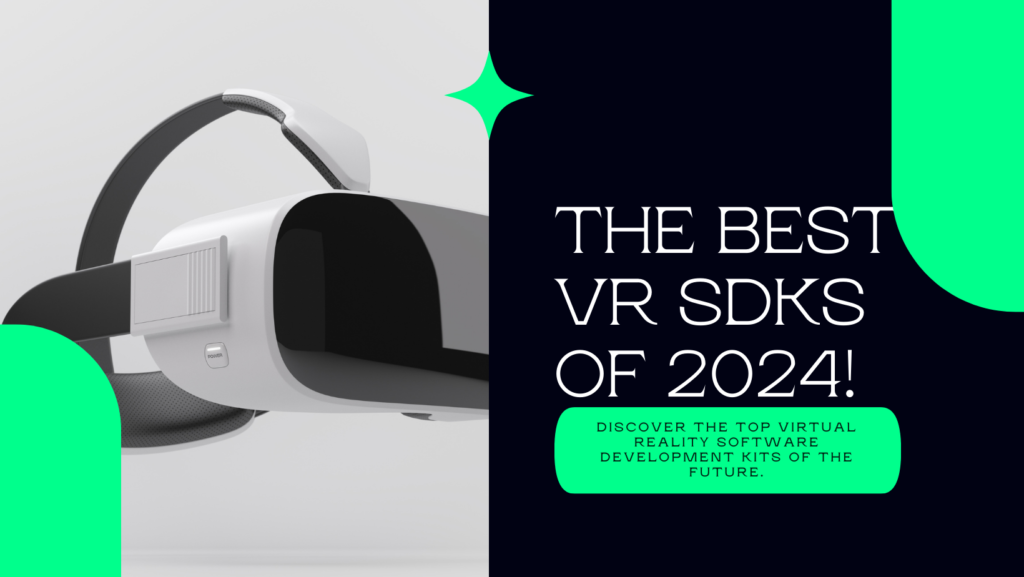
Virtual Reality (VR) has gone beyond just being cool to becoming a game-changer in how we interact digitally. Whether it’s for mind-blowing experiences, shaking up e-learning, or leading the way in product design, VR’s possibilities are huge! At the core of VR progress is the Software Development Kit (SDK) – a key tool empowering developers to craft VR content seamlessly. With the VR industry growing fast, picking the right VR SDK for your project has gotten trickier. This deep dive explores the top VR Software Development Kits for 2024, giving a detailed breakdown perfect for tech fans, VR devs, and software pros.
The Importance of SDKs in VR Development
In the virtuverse, an SDK is akin to a digital craftsman’s toolbox, housing a myriad of tools needed to chisel and sculpt the VR experience. It’s the foundation upon which VR worlds are built, offering essential components such as 3D modeling, animation, texturing, and more. The right VR SDK not only streamlines development but also enhances the potential to create rich and realistic VR environments.
Criteria for Evaluating VR SDKs
Before we plunge into the world of VR SDKs, it’s crucial to set the standard by which we’ll assess them. We’ll consider several key factors, including their compatibility across platforms, the learning curve for newcomers, the robustness of their community and technical support, the cost-benefit, and the suite of features they offer.
Virtual Reality (VR) is revolutionizing digital interactions with immersive experiences in e-learning and product design. The Software Development Kit (SDK) is crucial for crafting seamless VR content. Discover top VR SDKs for 2024 to navigate the expanding VR industry effectively.
Top VR Software Development Kits of 2024
Here are the top VR SDKs dominating the space this year, each with its strengths and a unique appeal.
Unity
Unity has been a stalwart name in the VR development landscape. It’s renowned for its cross-platform capabilities and a vast community, making it a go-to choice for many. The platform offers an extensive library of assets, an agile development interface, and robust support for VR hardware integration.
Pros of using Unity
- Extensive asset store with a plethora of 3D models and environment textures.
- Seamless integration with various VR peripherals and platforms.
- Scalable, suited for both beginners and professionals.
Cons of using Unity
- Requires some additional learning if not familiar with Unity’s game engine mechanics.
- Cost of subscription can be steep for independent developers.
Amazon Sumerian
Amazon Sumerian focuses on providing an easy entry point for those new to VR development. Its drag-and-drop interface and cloud-based architecture make it an accessible choice for rapid prototyping.
Pros of using Amazon Sumerian
- No software to install, works directly in the browser.
- Integrates with other Amazon Web Services seamlessly.
- Excellent for creating quick, web-based VR experiences.
Cons of using Amazon Sumerian
- Limited feature set compared to more established game engines.
- Lack of advanced functionality for complex projects.
Google VR SDK
Google VR SDK, now merged with Daydream, is another cross-platform SDK with a focus on mobile and browser-based VR experiences. It provides a suite of plugins and native libraries for various platforms, ensuring a cohesive VR experience across devices.
Pros of using Google VR SDK
- Uses standard mobile development tools, enhancing compatibility.
- Detailed documentation and strong community support.
- A consistent user experience across different devices.
Cons of using Google VR SDK
- Limited primarily to mobile and browser VR experiences.
- May lack features required for more robust or complex scenarios.
Unreal Engine
The Unreal Engine stands out with its cutting-edge graphics and extensive toolset for VR development. It’s particularly favored by those aiming for high-fidelity visuals and large-scale projects.
Pros of using Unreal Engine
- Pinnacle visuals and real-time rendering capabilities.
- Strong suite of graphical tools for VR environments.
- Free to start with royalties paid only after a certain revenue threshold.
Cons of using Unreal Engine
- Relatively higher learning curve, especially for beginners.
- More hardware intensive, necessitating stronger development machines.
Blender
Blender, though better known for its 3D modeling capabilities, has been making strides as a comprehensive VR development tool. With a strong focus on open-source principles, it stands as a cost-effective and flexible option.
Pros of using Blender
- Open-source and free to use, with no licensing fees.
- Continuously updated with new features and plug-ins.
- Solid 3D modeling and animation tools for VR content creation.
Cons of using Blender
- The interface can be overwhelming for newcomers.
- Documentation and community support are not as robust as paid options.
CryEngine
CryEngine excels at creating highly realistic and graphically superb VR environments, ideal for creating immersive VR experiences with a cinematic edge.
Pros of using CryEngine
- Industry-leading visuals and audio capabilities.
- Strong support for large, open world environments.
- Free to use for non-commercial projects.
Cons of using CryEngine
- Historically steeper learning curve compared to other engines.
- Limited asset store and marketplace compared to others.
Vuforia
Vuforia is an Augmented Reality (AR)/Mixed Reality (MR) framework that also dabbles in VR development. It’s tailored for industrial, retail, and e-commerce applications, offering features like object recognition and tracking, and creating AR/VR markers with ease.
Pros of using Vuforia
- Focuses on industry-specific features, a standout for particular use cases.
- Seamless integration and tracking of real-world objects in AR, leading to complex VR interactions.
- Part of the Unity ecosystem, which amplifies its capabilities.
Cons of using Vuforia
- Primarily focused on AR applications, so more generalized VR projects would find it lacking.
- Paid tier is required for more advanced AR and VR features.
Comparison of VR SDKs
| VR SDK | Cross-Platform Support | Ease of Development | Community Support | Cost | Feature Set |
|---|---|---|---|---|---|
| Unity | Excellent | Moderate to Advanced | Strong | Subscription | Broad |
| Amazon Sumerian | Moderate | Beginner Friendly | Standard | Free / Pay for use | Basic |
| Google VR SDK | Moderate | Beginner Friendly | Strong | Free | Standard |
| Unreal Engine | Good | Moderate to Advanced | Strong | Free with royalties | Extensive |
| Blender | Excellent | Moderate to Advanced | Moderate | Free | Extensive |
| CryEngine | Good | Moderate to Advanced | Moderate | Free | Extensive |
| Vuforia | Moderate to Good | Beginner to Advanced | Moderate | Subscription | Specific AR/VR features |
Emerging Trends
The VR landscape is a dynamic one, with trends continuously shaping the tools at our disposal. In 2024, we’re seeing SDKs push the boundaries with features like AI-assisted development, enhanced gesture controls, and a stronger focus on haptic feedback.
You may also like Augmented Reality Frameworks
Choosing the Right VR SDK
Finally, selecting an SDK boils down to understanding your project’s unique requirements. Consider the platform, scope, team expertise, and long-term goals. Whether it’s the ease of access, the depth of the feature set, or the strength of the community, each SDK offers a different blend of advantages.
Opportunity abounds in the realm of VR development, and the right SDK choice can make all the difference in bringing visions to virtual life. Evaluate your choices with the above criteria, stay attuned to industry shifts, and remember to always innovate within the virtuous balance of feasibility and ambition. For 2024 and beyond, VR SDKs are not just tools but the very scaffolding of our digital dreams.
Share to
Frequently Asked Questions (FAQ)
A VR SDK is suitable for beginners if it offers comprehensive documentation, a supportive community, and intuitive design interfaces that simplify the development process.
Yes, many of the top VR SDKs in 2024 offer cross-platform support, allowing developers to create applications that work across multiple VR platforms with minimal modifications.
Related Posts

7 Best Social Media AI Tools in 2024
Explore innovative solutions in latest social media AI tools designed to transform your online presence, streamline content creation, and optimize engagement.

Artificial Intelligence Algorithms
Artificial Intelligence algorithms are the backbone of modern intelligent systems, enabling machines to perform tasks that typically require human intelligence.

Innovations in AI for Education
Discover how Innovations in AI (Artificial Intelligence) is transforming education with personalized learning paths, intelligent tutoring systems, and predictive analytics for enhanced learning experiences.
